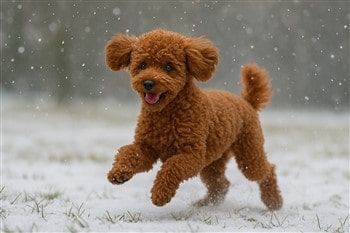Poodle Winter Care
Overview
For those of you who experience long, cold winter months, adjustments should be made regarding some care elements of Poodles, both puppies and adults.
Cold temperatures ,dry air and elements related to snow will have accumulating effects to many aspects of Poodles including coat, skin health, paws and nose. There may be behavioral or activity changes as well, such as appetite fluctuation and exercise requirements needing to be tweaked.
Since many of you with toy, miniature and standard Poodles can't avoid what Mother Nature brings from about mid-November to late March, preparing for winter and how this affects your Poodle is important.
This section will cover:
- Paws
- Nose
- Skin
- Coat
- Appetite
- Shivers, Tremors and Shaking
- Changes in behavior/ activity

Winterizing a Poodle's Paws
A Poodle's paws are most definitely a part of the body that feels the full effects of winter. The season has an effect in a various number of ways:
The cold ground -
Ground surfaces, including pavement and snowed areas, hold in the cold. This is particularly true in the early morning, after heat escapes all night long and before the sun comes out to even things out (this is called terrestrial radiation withdrawal).
What this does
- As the skin of a Poodle's paws is exposed to freezing or near-freezing surfaces over the course of days, weeks and months, they can become dry and cracked. Without treatment and with continued exposure, this can worsen, possibly with cracked paws becoming infected.
Ice melt chemicals & salt
- These are perhaps one of the biggest contributors of winter paw damage for Poodles. Even if you refrain from using these sorts of products or buy a pet safe brand, strong chemical melt products and salt are often dragged in from larger roads. City municipal services and even your neighbors can spread this and it is then tracked to other areas via vehicle tires and other means.
What this does
- Contact of a Poodle's paws onto ice melt can cause chemical burn. Salt can be just as bad, its gritty texture grinding into paw pads. Depending on how much is present and the frequency of the contact, a Poodle may develop issues to the paws rather quickly or it may be a gradual injury that does not present itself until winter is almost done.
The snow
- Walking on snow can do a number on a Poodle's paws in the winter. Tiny ice balls can get stuck between the dog's toes and pads. Some find walking on icy snow to be painful and will avoid heading out to designated bathroom areas.
Additional issues
- Due to discomfort induced by the above elements and/or due to dry skin issues, which are prevalent in the winter, a Poodle may lick and fuss with his paws much more often. This exasperates issues such as drying and peeling.
What to do - The best thing you can do for your Poodle as winter approaches and throughout the season is to protect his paws. This can be accomplished by 1 of 2 means:
1. Paw wax
- This is the #1 recommended method. The right paws wax works efficiently to provide many things:
- Traction on slippery surfaces
- Protection from the cold
- Moisture for dry paw skin & increasing playability and smoothness to the paws
- Acts as a barrier to prevent damage from any winter elements including ice melt & salt
- A good, quality paw wax or butter will also heal paws that are dry or peeling
You'll want to look for a quality brand that absorbs quickly and lasts for several days. With many top brands, application is done every 3 to 5 days or so, with the wax being rubbed in for 2 to 3 minutes. While you may want to apply this before going outside, a good paw wax can be applied at other times, as it will soak in rather quickly and not leave a film behind.
2. Doggie boots
- This is another option if your Poodle does not mind wearing doggie boots; some don't mind at all and others will fight it. While this will protect against salted road and cold surfaces, shoes do not moisture the paws nor does it heal drying, peeling and/or cracking pads and toes.
Winterizing a Poodle's Nose
A Poodle's nose is exposed and vulnerable to all that winter brings and the effects can be quite harsh. There are several winter related elements to be aware of:
Cold + licking = chapping.
Cold winters winds whip around a dog, that dog then licks his nose (dogs do this hundreds of times per day, so quickly that most owners do not notice) and then the wet nose becomes chapped. Only to again be exposed to the cold and as this cycles around, a Poodle's nose gets more and more damaged.
Dry air + licking = chapping.
The air is much drier in the wintertime due to low humidity levels. Even in the house, safe from the outside elements, a Poodle's nose can dry out, be licked all day (again, this happens no matter what) and this leads to drying and possible peeling and even cracking without protection.
What to do
- It's best to get ahead of the game by using a quality nose butter or balm before damage sets in. While some good brands will heal the nose as well, it's best to protect the Poodle's nose leather before any problems set in.
A good nose balm will have many benefits for your Poodle including:
- Protect from chapping
- Protect from windburn
- Heal noses conditions (drying, peeling, cracking, chapping, windburn and even some rashes)
Please note:
If the nose is deeply cracked with pus or blood, this is a sign of infection and should be treated by a veterinarian.
If you use a nose butter on your Poodle for protection and prevention, application is 1 time per day. If you are using this to treat an issue, it is normally applied 2 to 3 times per day.
Many owners find the benefits of nose balm to be advantageous all throughout the year, as it can also protect from sun damage in the summer.
Winterizing a Poodle's Skin & Coat
The main problem in the winter is that the super dry air affects a dog's skin and coat.
The humidity level in the winter is much lower than warmer months because cold air cannot hold moisture as warmer air can. That cold dry air is then heated in homes, however heating only warms it up; it does not add water. The previously cold air, now warmed from you heating system,
does have the
capacity to hold moisture.
So where does it gather moisture from? One place is from the skin of both humans and pets.
So if your Poodle develops dry skin during the winter and/or his coat
starts to look frizzed, dull and unhealthy, the winter air has a lot to do with this. Luckily, there are some great winter care tips for Poodles that can combat these issues:
1) Stay on schedule with baths. Owners tend to give less baths in the winter; after all, dogs are outside less and the ground is less muddy, etc. However, baths serve a purpose more than just removing dirt and debris. When a Poodle is given a bath with the right product, the shampoo will gently wash away accumulated body oils and debris, while both shampoo & conditioner will be adding vital moisture and offering important protection to the hair strands.
Also, if you skip baths you may soon find your Poodle starting to smell. Body oil is produced around the clock. At the 3 week mark, enough has built up on the surface, trapped near the hair's roots, to block skin pores and start to emit a bad odor. Washing this away is like starting with a fresh slate; pores are unblocked, smelly oils are cleansed away.
2) Use quality products.
Using the right shampoo and condition is vital. Inferior shampoos will be too harsh, stripping both skin and coat to a severe degree. Inferior conditions will glob up on the skin surface, clogging pores. Neither will moisture nor protect. You also don't want something heavy.
Look for a product that is sulfate free, is not packed with chemical ingredients and is PH balanced for canines. Those with an oatmeal base are great to both prevent and treat dry skin.
Choosing a leave-in product is also part of winter care for a Poodle. Contact friction and static are at an all-time high in the winter. This is applicable for all ages: puppies
that roll around and adults and seniors that rest on any surface: carpeting, the fabric of bedding, etc. A good leave-in spritz will also coat the hair strands to prevent split ends and offer a layer of protection. Use a light, yet effective spray, misting the roots and then using a brush to distribute it throughout the Poodle's coat.
3) Add moisture to the house.
While it's an uphill battle, the more moisture you can add to the air in your home, the better. The most effective method is to use humidifiers, one placed in each main room. If you find that your Poodle tends to have a dry cough, dry eyes or even develops a snoring problem
in the winter, placing the device close to his sleeping area can help a lot.
Other less effective methods, but those that can work if all done simultaneously, include leaving out bowls of water (placing on heating radiators if these are present), having an array of house plants and leaving the bathroom door open when showering.
Changing Appetite in the Winter
In general, you can expect a dog (of any breed, not just a Poodle) to eat up to 20% more during the winter than it the summer. However, it should be noted that some dogs eat 10- to 15% less. It really depends on the Poodle's environment and the structure of his day.
For Poodles that have a larger appetite
in the winter, this is often due to exposure to cold temperatures accelerating calorie expenditure and hormonal changes that trigger a dog to eat more as autumn turns into winter.
For Poodles that eat less in the winter, this is often due to a much lower activity level and therefore less calorie expenditure.
If feeding adjustments are not made, a Poodle can gain or lose weight. This is of particular concern with toy Poodles
that are already very small, however Poodle of all varieties should be fed to maintain a healthy weight (or a steady gain, for growing puppies).
Behavioral Changes in the Winter & Activity Level
If you live in an area that receives snowstorms, ice storms and blizzards, you know the feeling of being cooped up.
At first, it may be comforting to stay inside nice and warm. But then as the snow mounts, there is an increasing desire to simply break free and get out.
Well, dogs feel this too. And the canine equivalent of cabin fever can develop even if the ground is clear and the temperature is above freezing. Why? Because with short days and cold weather, owners often cut walks short and decrease their frequency.
When a Poodle is walked less often or walked for shorter amounts of time, this causes a buildup of energy that is not properly released. It can lead to chewing problems, restless behavior such as barking, pacing or an agitated state and can even exasperate separation anxiety issues.
What to do:
As much as possible, stick to your Poodle's normal activity schedule. Here are some tips:
1) Shovel pathways and play areas.
Whether you have a young puppy still trying to get down the basics of housebreaking
or an older adult that does well, keeping the bathroom area in the same place, no matter the season or weather, is the best thing to do. Depending on where this is, you may need to do some shoveling to keep the pathway to it clear. It can also help to have a good sized area kept clear of snow for some outdoor exercise.
2) Don't depend on indoor activity.
Dogs, even tiny ones like toy Poodles, do not 'self-exercise' by running around in the house. While this is, of course, better than a dog just resting all day, purposeful walking at a brisk pace along an outside route is best. When a dog is walked, movement is important. But just as vital is the freeing feeling of leaving the house and the opportunity for the dog to smell & see different scents and sights; this calms a canine's need to explore.
3) But do have alternatives.
For blustery days below freezing or on days when it's snowing hard, do plan to at least play a rousing game of fetch or hide n' seek with your Poodle, to get the heart pumping when stuck inside. A good 20 minutes or so, once or twice a day is best.
4) Dress both you
and your Poodle for the weather.
Keeping a dog warm during the season is only half the challenge. Many dogs are brought back inside prematurely when the owner is freezing their butt off. If you bundle up properly, there's a much better chance you'll stay outside long enough for your dog to receive his/her proper exercise.
In regard to Poodles, the single coat of hair doesn’t do much to protect from the winter cold. Have a nice selection of 2 or 3 sweaters, hoodies or coats to choose from. If a dog's main body (chest, back, flanks) are warm and paws are protected, he can enjoy going out in all but the worst weather conditions.
A Final Word
Some people love winter and others anxiously count the days until spring, it just can't come soon enough. However one thing is for sure, the Poodle breed is an indoor dog that needs help making it through the winter.
Plan ahead on how you will prep and maintain your Poodle throughout the cold season for a happy and health dog.

